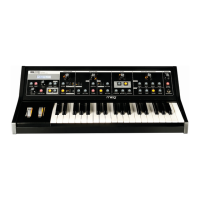Page 46
LP User’s Manual - Glossary
Page 47
LP User’s Manual - Glossary
Frequency – The rate of vibration in sound measured in Hertz (Hz or cycles per second). The average hearing
range of the human ear is from 20 to 20,000 Hz. Frequency corresponds to the musical term ‘pitch’, but the
two terms are not always interchangeable. Frequency is an objective measurement of a sound, while pitch
is the perception of a sound, low, high, or mid-ranged. A low frequency corresponds to a low-pitched sound
such as a bass; a high frequency sound corresponds to a high-pitched sound such as a piccolo. In music, a
change in pitch of one octave higher equals a doubling of the frequency.
Frequency Modulation – Also known as FM, Frequency Modulation describes the technique of using one
oscillator to modulate the frequency of another. In FM, the modulating oscillator is called the ‘modulator’,
while the other oscillator is known as the ‘carrier’. The carrier oscillator is the one you hear. When the
modulator frequency is very low (about 6Hz), the effect is described as vibrato. As the modulator frequency
is raised into the audio range, new modulation frequency components are created, and the effect is
perceived as adding new overtones to the carrier signal.
Glide – Also called portamento, is the slowing down of pitch changes as you play different notes on the
keyboard. Certain acoustic instruments, like the trombone or the violin, create this effect when the
performer adjusts the tubing or string length. The speed of the glide is the glide rate. In synthesizers, a Glide
Rate control determines how the speed of the glide between notes.
Harmonic – A sound is made up of simple vibrations at many different frequencies (called harmonics) that give a
sound its particular character. This corresponds to the musical term timbre or tone color. A harmonic sound,
such as a vibrating string, is one in which the harmonics are mathematically related by what is called the
harmonic series. These sounds are typically pleasing to the ear and generally the consecutive vibrations have
the same characteristic shape or waveform. An inharmonic sound, such as a crash cymbal, is one in which
the harmonics are not mathematically related. Their waveforms look chaotic. White noise is an inharmonic
sound that contains equal amounts of all frequencies.
Little Phatty – A monophonic analog synthesizer designed by Bob Moog that is a descendant of the classic
Minimoog.
Low Frequency Oscillator – Also called an LFO, this is a special type of oscillator that generates signals
primarily below the range of human hearing (generally below 20 Hz). LFOs are typically used as a source
of modulation. For instance, an LFO with a triangle waveform, set to about 6 Hz and modulating the pitch
of a VCO results in vibrato. Changing the LFO waveform to a square wave will result in a trill. An LFO
modulating a VCA with a triangle wave creates tremolo.
Mixer – A circuit for combining multiple sound sources or signals.
Modulation – Modulation is the use of a control voltage to shape a tone. Modulation has a source, a destination,
and an amount. This could be as simple as the lter cutoff of a VCF (a modulation destination) being
changed by the front panel cutoff control (the source), or as complex as mixing multiple CVs together to
modulate lter cutoff. Modulation is used in synthesis to create complex sounds and add variation.
Oscillator – A circuit that electronically “vibrates”. When used as a sound source, an oscillator is the electronic
equivalent of a vibrating reed, or string. When amplied, an oscillator produces a pitched sound whose
frequency is determined by one or more control voltages. Changes to these voltages correspond to changes
in pitch. An oscillator’s vibration can have different shapes or waveforms, such as a triangle, sawtooth, or
square wave. The Little Phatty has two oscillators for generating sounds.

